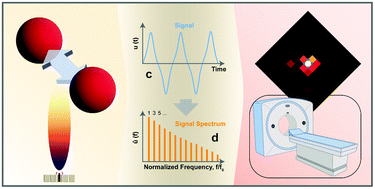Particle interactions and their effect on magnetic particle spectroscopy and imaging†
Abstract
Signal stability is crucial for an accurate diagnosis via magnetic particle imaging (MPI). However, MPI-tracer nanoparticles frequently agglomerate during their in vivo applications leading to particle interactions altering the signal. Here, we investigate the influence of such magnetic coupling phenomena on the MPI signal. We prepared Zn0.4Fe2.6O4 nanoparticles by flame spray synthesis and controlled their inter-particle distance by varying SiO2 coating thickness. The silica shell affected the magnetic properties indicating stronger particle interactions for a smaller inter-particle distance. The SiO2-coated Zn0.4Fe2.6O4 outperformed the bare sample in magnetic particle spectroscopy (MPS) in terms of signal/noise, however, the shell thickness itself only weakly influenced the MPS signal. To investigate the importance of magnetic coupling effects in more detail, we benchmarked the MPS signal of the bare and SiO2-coated Zn-ferrites against commercially available PVP-coated Fe3O4 nanoparticles in water and PBS. PBS is known to destabilize nanoparticle colloids mimicking in vivo-like agglomeration. The bare and coated Zn-ferrites showed excellent signal stability, despite their agglomeration in PBS. We attribute this to their process-intrinsic aggregated morphology formed during their flame-synthesis, which generates an MPS signal only little affected by PBS. On the other hand, the MPS signal of commercial PVP-coated Fe3O4 strongly decreased in PBS compared to water, indicating strongly changed particle interactions. The relevance of this effect was further investigated in a human cell model. For PVP-coated Fe3O4, we detected a strong discrepancy between the particle concentration obtained from the MPS signal and the actual concentration determined via ICP-MS. The same trend was observed during their MPI analysis; while SiO2-coated Zn-ferrites could be precisely located in water and PBS, PVP-coated Fe3O4 could not be detected in PBS at all. This drastically limits the sensitivity and also general applicability of these commercial tracers for MPI and illustrates the advantages of our flame-made Zn-ferrites concerning signal stability and ultimately diagnostic accuracy.



 Please wait while we load your content...
Please wait while we load your content...